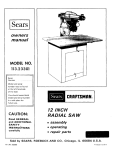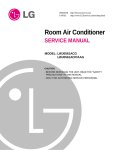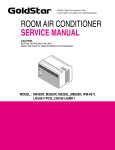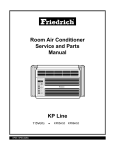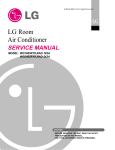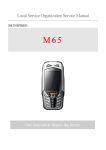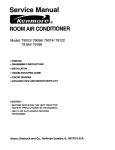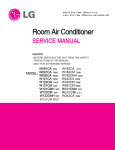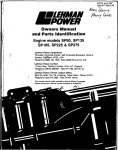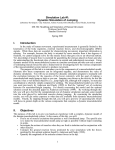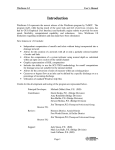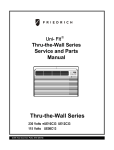Download LG Room Air Conditioner
Transcript
website http://www.lgservice.com LG LG Room Air Conditioner SERVICE MANUAL MODEL: TWC051HGAA2.AWYBLAT (W051CA) TWC052HGAA0.AWYBLCP (LA050MG) TWC061HGAA2.AWYBLAT (W061CA) TWC062HGAA0.AWYBLCP (LA060MG1) CAUTION • BEFORE SERVICING THE UNIT, READ THE SAFETY PRECAUTIONS IN THIS MANUAL. • ONLY FOR AUTHORIZED SERVICE PERSONNEL. Air Conditioner Service Manual TABLE OF CONTENTS Safety Precautions..........................................................................................................................................3 Dimensions .....................................................................................................................................................5 Outside Dimensions ...................................................................................................................................5 Product Specifications ..................................................................................................................................6 Installation .......................................................................................................................................................7 Select the Best Location ...........................................................................................................................7 How to Install..............................................................................................................................................7 Operation ........................................................................................................................................................8 Features .....................................................................................................................................................8 Insulation Resistance Test..........................................................................................................................8 About the Controls on the Air conditioner ..................................................................................................8 Disassembly ....................................................................................................................................................9 Mechanical Parts........................................................................................................................................9 Air Handling Parts ....................................................................................................................................10 Electrical Parts .........................................................................................................................................11 Refrigerating Cycle...................................................................................................................................12 Schematic Diagram.......................................................................................................................................15 Wiring Diagram.........................................................................................................................................15 Troubleshooting Guide .................................................................................................................................16 Piping System ..........................................................................................................................................16 Troubleshooting Guide .............................................................................................................................17 Room Air Conditioner Voltage Limits........................................................................................................19 Exploded View ..............................................................................................................................................22 Replacement Parts List ................................................................................................................................23 2 Room Air Conditioner Safety Precautions Safety Precautions To prevent injury to the user or other people and property damage, the following instructions must be followed. ■ Incorrect operation due to ignoring instruction will cause harm or damage. The seriousness is classified by the following indications. WARNING This symbol indicates the possibility of death or serious injury. CAUTION This symbol indicates the possibility of injury or damage to property only. ■ Meanings of symbols used in this manual are as shown below. Be sure not to do. Be sure to follow the instruction. WARNING ■ Installation Do not use damaged power cord plugs, or a loose socket. • There is risk of fire or electric shock. Always use the power plug and socket with the ground terminal. • There is risk of electric shock. Service Manual 3 Safety Precautions Do not modify or extend the power cord. • There is risk or fire or electric shock. Do not install, remove, or re-install the unit by yourself. • There is risk of fire, electric shock, explosion, or injury. Be cautious when unpacking and installing the product. • Sharp edges could cause injury. Be especially careful of the case edges and the fins on the condenser and evaporator. Do not store or use flammable gas or combustibles near the air conditioner. • There is risk of fire or failure of product. Sharp edges Gasolin Be sure the installation area does not deteriorate with age. • If the base collapses, the air conditioner could fall with it, causing property damage, product failure, and personal injury. 4 Room Air Conditioner Dimensions Dimensions Symbols Used in this Manual This symbol alerts you to the risk of electric shock. This symbol alerts you to hazards that could cause harm to the air conditioner. NOTICE This symbol indicates special notes. Outside Dimensions D W Operation Off High Fan High Cool Low Cool H Low Fan Thermostat 5 4 6 3 7 2 8 1 9 Model All Model Dimension W mm(inch) 472(18 9/16") H mm(inch) 312(12 1/4") D mm(inch) 370(14 9/16") Service Manual 5 Product Specifications Specifications 1.Product SPECIFICATIONS . . ITEMS MODELS . W061CA LA050MG 1ø, 115V~, 60Hz POWER SUPPLY COOLING CAPACITY INPUT (W) RUNNING CURRENT E.E.R W051CA (A) (BTU/W.h) OPERATING INDOOR CONDITION OUTDOOR (°C) 1ø, 230V~, 60Hz 5050 Btu/h 6000 Btu/h 5500KJ/H 6000KJ/H 520 620 520 555 4.8 5.8 2.4 2.5 9.7BTU/W.h 9.7BTU/W.h 10.6KJ/H-W 10.8KJ/H-W 27(DB)* (°C) REFRIGERANT (R-22) CHARGE LA060MG1 35(DB)* 19(WB)** 24(WB)** 220 35(DB)* 27(WB)** 250 270 Ø7 2R 10C SLIT-FIN EVAPORATOR Ø5 2R 10C SLIT-FIN CONDENSER Ø7 1R 14C, LOUVERED-FIN Ø5 2R 14C, LOUVERED-FIN TURBO FAN FAN, INDOOR PROPELLER TYPE FAN WITH SLINGER-RING FAN, OUTDOOR FAN SPEEDS, FAN/COOLING 2/2 4 POLES FAN MOTOR OPERATION CONTROL ROTARY SWITCH ROOM TEMP. CONTROL THERMOSTAT AIR DIRECTION CONTROL 2WAY (RIGHT & LEFT) CONSTRUCTION TOP DOWN CHASSIS COMPRESSOR OVERLOAD PROTECTOR(Internal) FAN MOTOR INTERNAL THERMAL PROTECTOR PROTECTOR (3 WIRE WITH GROUDING) POWER CORD ATTACHMENT PLUG (CORD-CONNECTED TYPE) DRAIN SYSTEM DRAIN PIPE OR SPLASHED BY FAN SLINGER * DB:Dry Bulb **WB:Wet Bulb NOTICE SPECIFICATIONS ARE SUBJECT TO MINOR CHANGE WITHOUT NOTICE FOR FURTHER IMPROVEMENT. 6 Room Air Conditioner Installation Installation This air conditioner is designed with a button-down chassis so it can be easily installed in a window. Select the Best Location CAUTION: All side louvers of the cabinet must remain exposed on the outdside of the structure. 4. Install the unit slanted slightly so the back is slightly lower than the front (about 1/4"). This will force condensed water to the outside. 5. Install the unit with the bottom about 30"~60" above the floor level. INSIDE OUTSIDE FENCE AWNING OOLED AIR 30"-60" 1. To prevent vibration and noise, make sure the unit is installed securely and firmly. 2. Install the unit where the sun does not shine directly on the unit. 3. The outside of the cabinet must extend outward for at least 10" and there should be no obstacles, such as a fence or wall, within 20" from the back of the cabinet because it will prevent heat radiation of the condenser. Restriction of outside air will greatly reduce the cooling efficiency of the air conditioner. HEAT RADIATION ABOUT 1/4 " Over 20" Figure 1 How to Install Window Requirements NOTICE INNER SILL All supporting parts should be secured to firm wood, masonry, or metal. 1. This unit is designed for installation in standard double hung windows with actual opening widths of 22" to 36". The upper and lower sash must open sufficiently to allow a clear vertical opening of 13" from the bottom of the OUTER sash to the window stool. SILL 2. If storm window presents interference, fasten a 2" wide INDOORS OUTDOORS wood strip to the inner window sill across the full width of Figure 2 the sill. The wood strip should be thick enough to raise the height of the window sill so that the unit can be 1" MAX. WOOD STRIP MOUNTED 3 /4 " installed without interference by the storm window frame. ON TOP OF INNER SILL CLEARANCE See Figure. 3. Top of wood strip should be approximately 3/4" higher than the storm window frame (STORM WINSTORM DOW FRAME) or wood strip (OUTDOORS) to help conWINDOW densation to drain properly to the outside. INNER FRAME SILL 3. Install a second wood strip (approximately 6" long by WOOD STRIP 11/2" wide and same thickness as first strip) in the center FOR L BRACKET of the outer sill flush against the back off the inner sill. OUTER This will raise the L bracket as shown Figure. 3. SILL 4. If the distance between STORM WINDOW FRAME and INDOORS OUTDOORS WOOD STRIP MOUNTED ON TOP OF INNER SILL is Figure 3 more than 1", two of wood strip are not necessary. Service Manual 7 Operation Operation Feature • DESIGNED FOR COOLING ONLY • POWERFUL AND INCREDIBLE COOLING • TOP-DOWN CHASSIS FOR THE SIMPLE INSTALLATION AND SERVICE • BUILT-IN ADJUSTABLE THERMOSTAT • WASHABLE ONE-TOUCH FILTER • COMPACT SIZE Insulation Resistance Test INSULATION RESISTANCE TEST 1. Unplug the power cord and connect a jumper between 2 pins (black and white). 2. The grounding conductor (green or green and yellow) is to be open. 3. Measure the resistance value with an ohm meter between the jumpered lead and each exposed metallic part on the equipment at all positions [except Off] of the ROTARY SWITCH. 4. The value should be over 1 MΩ. About the jControls or the Air Conditioner Operation Off High Fan High Cool Low Fan Low Cool Off High Fan Low Fan High Cool Low Cool - Turns air conditioner off. - High speed fan operation without cooling. - Low speed fan operation without cooling. - Cooling with high speed fan operation. - Cooling with low speed fan operation. FAN ONLY- Fan operation without cooling. TURBO COOL - Cooling with high speed fan operation. Thermostat 5 4 6 3 7 2 8 1 9 8 Room Air Conditioner This automatically controls the temperature of the indoor air. Turn the knob so that arrow points to the larger marks for greater cooling. Point the arrow to the smaller marks for more moderate cooling. (i.e. the higher number, the greater cooling) Disassembly Disassembly Mechanical Parts 1. FRONT GRILLE 1. Disconnect the unit from source of power. 2. Remove the two knobs by pulling them off. Using a screwdriver, remove the screw that secures the front grille to control board. (See Figure 13) 3. Push the front grille up from the bottom. Pull the top of the front grille away from the cabinet as the top tabs lift out of their slots. (See Figure 14) 4. Replace the grille by placing the tabs in the slots and push the grille until it snaps into place. Figure 13 2. CABINET 1. Disconnect the unit from the power source. 2. Remove the front grille. (Refer to section 1) 3. Remove 9 screws that secure the cabinet to the base pan and condenser. (See Figure 15) 4. Lift the cabinet from the unit. 5. Re-install by referring to the procedures above. Figure 14 3. CONTROL BOARD 1. Disconnect the unit from the power source. 2. Remove the front grille. (Refer to Section 1) 3. Remove the cabinet. (Refer to Section 2) 4. Remove 2 screws that secure the control board to base pan and air guide. (See Figure 16) 5. Pull the control board toward yourself. NOTICE Figure 15 Controls, wires, and capacitor are now accessible for servicing. Discharge the capacitor before servicing. See step 2.3.3 on page 8 for procedures. 6. Disconnect one housing terminal and 3 wires for the fan motor and compressor. (See Figure 17) 7. Re-install components by referring to procedures above. (Refer to wiring diagram on page 17 in this manual or inside control board.) Figure 16 Figure 17 Service Manual 9 Disassembly Air Handling Parts 4. AIR GUIDE UPPER 1. Disconnect the unit from the power source. 2. Remove the front grille. (Refer to Section 1) 3. Remove the cabinet. (Refer to Section 2) 4. Remove the control board. (Refer to Section 3) 5. Remove 2 screws that secure the brace to air guide upper and shroud. (See Figure 18) 6. Remove 2 screws that secure the air guide upper to air guide lower. (See Figure 8) Figure 18 7. Lift air guide upper upward. 8. Re-install by referring to the procedures above. 5. ORIFICE, TURBO FAN AND FAN 1. Disconnect the unit from the power source. 2. Remove the front grille. (Refer to Section ) 3. Remove the cabinet. (Refer to Section 2) 4. Remove the control board. (Refer to Section 3) 5. Remove the air guide upper. (Refer to Section 24) Figure 19 6. Remove 2 screws that secure the base pan to condenser. (See Figure 19) 7. Remove 2 screws that secures the shroud to channel of condenser. 8. Press the snap area of shroud with your thumbs. This allows you to remove it from the condenser. 9. Lift the compressor upward with the evaporator and condenser. (See Figure 19) 10. Remove the orifice by pushing the snap area of the air guide blower. (See Figure 20) 11. Remove the clamp springs which are clamped to the boss of fan and turbo fan by hand plier. (See Figure 21) Figure 20 12. Pull the fan and turbo fan outward. 13. Remove the shroud. 14. Re-install by referring to the procedures above. Figure 21 10 Room Air Conditioner Disassembly 6. MOTOR 1. Disconnect the unit from the power source. 2. Remove the front grille. (Refer to Section 1) 3. Remove the cabinet. (Refer to Section 2) 4. Remove the control board. (Refer to Section 3) 5. Remove the air guide upper. (Refer to Section 4) 6. Remove the compressor, turbo fan, fan and shroud. (Refer to Section 5) 7. Remove 2 screws that secure the motor to the motor. (See Figure 22) 8. Remove the motor. 9. Re-install by referring to the procedures above. 7. AIR GUIDE 1. Disconnect the unit from the power source. 2. Remove the front grille. (Refer to Section 1) 3. Remove the cabinet. (Refer to Section 2) 4. Remove the control board. (Refer to Section 3) 5. Remove the air guide upper. (Refer to Section 4) 6. Remove the compressor, turbo fan, fan and shroud. (Refer to Section 5) 7. Remove the motor. (Refer to Section 6) 8. Remove 2 screws that secure the air guide to the base pan. (See Figure 23) 9. Push the air guide backward and lift it upward. (See Figure 23) 10. Re-install by referring to the procedures above. Figure 22 Figure 23 Electrical Parts 8. OVERLOAD PROTECTOR 1. Remove the front grille and cabinet. (Refer to Section 1, 2) 2. Remove the nut which fastens the terminal cover. 3. Remove the terminal cover. 4. Remove all the leads from the overload protector. 5. Remove the overload protector. 6. Re-install the components by referring to the removal procedure above. (See Figure 24 and 25) 9. COMPRESSOR 1. Remove the front grille and cabinet. (Refer to Section 1, 2) 2. Discharge the refrigerant by using a refrigerant recovery system. 3. Remove the overload protector. (Refer to Section 8) 4. After discharging the unit completely, unbrace the suction and discharge pipes at the compressor connections. 5. Remove 3 nuts which fasten the compressor. 6. Remove the compressor. 7. Re-install by referring to the removal procedure above. (See Figure 25) Figure 22 Figure 24 Figure 25 Service Manual 11 Disassembly 10. CAPACITOR 1. Remove the cabinet. (Refer to Section 2) 2. Remove the control board. (Refer to Section 3) 3. Discharge the capacitor by placing a 20 KΩ resistor across the capacitor terminals. 4. Remove the screw which fastens the capacitor clamp. 5. Remove all the leads of capacitor terminals. 6. Re-install the components by referring to the removal procedure above. (See Figure 26) 11. THERMOSTAT 1. Remove the cabinet. (Refer to Section 2) 2. Remove the control board. (Refer to Section 3) 3. Remove 2 screws which fasten the thermostat. (See Figure 27) 4. Remove all the leads of the thermostat terminals. 5. Remove the thermostat. 6. Re-install the components by referring to the removal procedure above. 12. ROTARY SWITCH 1. Remove the cabinet. (Refer to Section 2) 2. Remove the control board. (Refer to Section 3) 3. Remove 2 screws which fasten the rotary switch. (See Figure 28) 4. Remove all the leads of the rotary switch terminals. 5. Remove the rotary switch. 6. Re-install the components by referring to the removal procedure above. 13. POWER CORD 1. Disconnect the unit from source of power. 2. Remove the front grille. (Refer to Section 1) 3. Remove the cabinet. (Refer to Section .2) 4. Remove a screw that secures control board to base pan and air guide. (Refer to Section 3) 5. Pulls the control board toward you. 6. Disconnect the 2 receptacles and remove the grounding screw. 7. Remove a screw securing the clip with cord to the control board. (See Figure 29) 8. Pull the power cord. 9. Re-install by referring to procedures above. Figure 26 Figure 27 Figure 28 Figure 29 Refrigerating Cycle 14. CONDENSER 1. Remove the cabinet. (Refer to Section 2) 2. Discharge the refrigerant by using a refrigerant recovery system. 3. Remove 2 screws which fasten the condenser. (See Figure 30) 4. After discharging the refrigerant completely, unbraze the interconnecting tube at the condenser connections. 5. Remove the condenser. 6. Re-install by referring to the procedures above. 12 Room Air Conditioner Figure 30 Disassembly 15. EVAPORATOR 1. Remove the cabinet. (Refer to Section 2) 2. Discharge the refrigerant by using a refrigerant recovery system. 3. Remove the air guide upper. (Refer to Section 4) 4. After discharging the refrigerant completely, unbraze the interconnecting tube at the evaporator connections. 5. Remove the evaporator. 6. Re-install by referring to the procedures above. 16. CAPILLARY TUBE 1. Remove the cabinet. (Refer to Section 2) 2. Discharge the refrigerant by using a refrigerant recovery system. 3. Remove the air guide upper. (Refer to Section 4) 4. After discharging the refrigerant completely, unbraze the interconnecting tube of the capillary tube. 5. Remove the capillary tube. 6. Re-install by referring to the procedures above. NOTICE Replacement of the refrigeration cycle. 1. When replacing the refrigerating cycle, be sure to discharge the refrigerant by using a refrigerant recovery system. 2. After discharging the unit completely, remove the desired components, and unbraze the pinch-off tubes. 3. Solder service valves into the pinch-off tube ports, leaving the valves open. 4. Solder the pinch-off tubes with service valves. 5. After completing the above procedures, the valve must be closed and left in place on the system for any subsequent procedures. 6. Evacuate as follows: 6-1. Connect the vacuum pump, as illustrated in figure 31A. 6-2. Start the vacuum pump. Slowly open manifold valves A and B with two full turns counterclockwise and leave the valves closed. The vacuum pump is now pulling through valves A and B up to valve C by means of manifold and the entire system. CAUTION: If high vacuum equipment is used, just crack valves A and B for a few minutes, then open slowly with the two full turns counter-clockwise. This will keep oil from foaming and being drawn into the vacuum pump. 6-3. Operate the vacuum pump for 20 to 30 minutes, until 600 micron vacuum is obtained. Close valves A and B and observe vacuum gauge for a few minutes. A rise in pressure would indicate a possible leak or moisture remaining in the system. With valves A and B closed, stop the vacuum pump. 6-4. Remove the hose from the vacuum pump and place it on the charging cylinder. See figure 20B. Open valve C. Discharge the line at the manifold connection. 6-5. The system is now ready for final charging. 7. Recharge as follows: 7-1. Rotary compressor systems are charged from the high-side. If the total charge cannot be put in the high-side, the balance will be put in the suction line through the access valve which is installed as the system is opened. 7-2. Connect the charging cylinder as shown in figure 31B. With valve C open, discharge the hose at the manifold connection. 7-3. Open valve A and allow the proper charge to enter the system. Valve B is still closed. 7-4. If more charge is required, the high-side will not take it. Close valve A. 7-5. With the unit running, open valve B and add the balance of the charge. a. Do not add the liquid refrigerant to the lowside. b. Watch the low-side gauge, allow pressure to rise to 30 lbs(0.2MP). c. Turn off valve B and allow the pressure to drop. d. Repeat steps B and C until the balance of the charge is in the system. 7-6. When the unit is operating correctly, use the pinch-off tool with the unit still running and the clamp on the pinch-off tube. Using a tube cutter, cut the pinch-off tube about 2 inches from the pinch-off tool. Use sil-fos solder and solder the pinch-off tube closed. Turn off the unit, allow setting for a while and then test the leakage of the pinch-off connection. Service Manual 13 Disassembly Equipment needed: Vacuum pump, charging cylinder, manifold gauge, brazing equipment, pinch-off tool capable of making a vapor proof seal, leak detector, tubing cutter, hand tools to remove components and service valve. COMPOUND GAUGE MANIFOLD GAUGE B CONDENSER (HIGH PRESSURE SIDE) A SEE INSETS BELOW COMPRESSOR EVAPORATOR (LOW PRESSURE SIDE) CAPILLARY TUBE LO HI CHARGING CYLINDER A B EXTERNAL VACUUM PUMP B A C Figure 31A-Pulling Vacuum 14 Room Air Conditioner Figure 31B-Charging Schematic Diagram Schematic Diagram Wiring Diagram • MODEL: W051CA LA050MG W061CA LA060MG1 1 4 2 6 3 7 5 REF. NO DESCRIPTION & NAME Q'TY 1 POWER CORD ASSY 1 2 FAN MOTOR 1 3 COMPRESSOR 1 4 ROTARY SWITCH 1 5 THERMOSTAT 1 6 CAPACITOR 1 7 OVERLOAD PROTECTOR 1 Service Manual 15 Troubleshooting Guide Troubleshooting Guide Piping System CONDENSER COILS FAN MOTOR CAPILLARY TUBE TURBO FAN EVAPORATOR COILS Following is a brief description of the important components and their function in what is called the refrigeration system. Reference should be made to Figure 33 to follow the refrigerating cycle and the flow of the refrigerant in the cooling cycle. ROOM AIR CONDITIONER CYCLE OF REFRIGERATION EVAPORATOR COILS CONDENSER COILS SUCTION LINE COOL LOW PRESSURE VAPOR COMPLETE LIQUID BOIL OFF POINT COOLED AIR VAPOR INLET HOT DISCHARGED AIR ROOM AIR HEAT LOAD OUTSIDE COOLING AIR FOR REFRIGERANT PASS THROUGH MOTOR COMPRESSOR DISCHARGE LINE NOT HIGH PRESSURE VAPOR OIL LIQUID PRESSURE DROP LIQUID OUTLET (LIQUID REFRIGERANT) HIGH PRESSURE VAPOR CAPILLARY TUBE LIQUID REFRIGERANT LOW PRESSURE VAPOR Figure 33 16 Room Air Conditioner Troubleshooting Guide Troubleshooting Guide In general, possible trouble is classified in two kinds. The one is called Starting Failure which is caused by an electrical defect. The other is Ineffective Air Conditioning caused by a defect in the refrigeration circuit and improper application. Unit is running but cooling is ineffective. Ineffective Cooling Check cold air circulation for smooth flow. Check outdoor coil (heat exchanger) and fan operation. Dirty indoor coil (heat exchanger) Check gas leakage. Check heat load increase. Clean condenser. Not on separate circuit Repair gas leak. Malfunction of fan. Clogging of air filter. Replacement of unit if the unit is beyond repair. Check inside gas pressure. Adjust refrigerant charge. Obstruction at air outlet. Remove obstruction. Malfunction of compressor. Check clogging in refrigeration circuit. Replacement of compressor. Repair clogging in refrigeration circuit. Satisfactory operation with temperature difference of inlet & outlet air; 44~50°F (7~10°C) Service Manual 17 Troubleshooting Guide Fails to Start Check of power source. Check of circuit breaker and fuse. Check of control switch setting. Gas leakage of feeler bulb of thermostat. Check control switch. Compressor fails only to start. Drop of power voltage. Fan only fails to start. Improper thermostat setting Defect of compressor capacitor. Loose terminal connection Capacitor check. Improper wiring Improper wiring. Defect of fan motor capacitor. Irregular motor resistance (Ω) Irregular motor insulation (Ω) Replacement. Replacement of fan motor. Irregular motor resistance (Ω) Irregular motor insulation (Ω) Replacement of compressor (Motor damaged). 18 Room Air Conditioner Regular but fails to start. Replacement of compressor. (Locking of piston, metal.) Troubleshooting Guide Room Air Conditioner Voltage Limits NAME PLATE RATING 115V ± 10% 230V ± 10% COMPLAINT Fan motor will not run. MINIMUM MAXIMUM 103.5V 126.5V 207V CAUSE 253V W051CA W061CA LA050MG LA060MG1 REMEDY No power Check voltage at outlet. Correct if none. Power supply cord Check voltage to rotary switch. If none, check power supply cord. Replace cord if circuit is open. Rotary switch Check switch continuity. Refer to wiring diagram for terminal identification. Replace switch if defective. Wire disconnected or connection loose Connect wire. Refer to wiring diagram for terminal identification. Repair or replace loose terminal. Capacitor (Discharge capacitor before testing.) Test capacitor. Replace if not within ±10% of manufacturer's rating. Replace if shorted, open, or damaged. Will not rotate Fan blade hitting shroud or blower wheel hitting scroll. Re-align assembly. Units using slinger ring condenser fans must have 0.22~0.25 inch clearance to the base. If necessary, shim up the bottom of the fan motor with mounting screw(s). Check fan motor bearings; if motor shaft will not rotate, replace the motor. Fan motor runs. Revolves on overload Check voltage. See limits on this page. If not within limits, call an electrician. Test capacitor. Check bearings. Does the fan blade rotate freely? If not, replace fan motor. Pay attention to any change from high speed to low speed. If the speed does not change, replace the motor. Service Manual 19 Troubleshooting Guide COMPLAINT Fan motor noise. Compressor will not run, fan motor runs. CAUSE REMEDY Fan If cracked, out of balance, or partially missing, replace it. Blower If cracked, out of balance, or partially missing, replace it. Loose set screw Tighten it. Worn bearings If knocking sounds continue when running or loose, replace the motor. If the motor hums or noise appears to be internal while running, replace motor. Voltage Check voltage. See the limits on the preceding page. If not within limits, call an electrician. Wiring Check the wire connections; if loose, repair or replace the terminal. If the wires are disconnected, refer to wiring diagram for identification, and replace the wires. Check the wire connections; If not according to the wiring diagram, correct the connections. Rotary Check for continuity, refer to the wiring diagram for terminal identification. Replace the switch if the circuit is open. Thermostat Check the position of knob. If not at the coldest setting, advance the knob to this setting and restart the unit. Check the continuity of the thermostat. Replace the thermostat if the circuit is open. Compressor cycles on overload. 20 Room Air Conditioner Capacitor (discharge capacitor before servicing.) Check the capacitor. Replace if not within ±10% of manufacturer’s rating, replace if shorted, open, or damaged. Compressor Check the compressor for open circuit or ground. If open or grounded, replace the compressor. Overload Check the compressor overload if externally mounted. Replace if open. (If the compressor temperature is high, remove the overload, cool, and retest.) Voltage Check the voltage. See the limits on the preceding page. If voltage is not within these limits, call an electrician. Overload Check overload, if externally mounted. Replace if open. (If the compressor temperature is high, remove the overload, cool, and retest.) Troubleshooting Guide COMPLAINT Compressor cycles on overload. Insufficient cooling Excessive noise CAUSE REMEDY Fan motor If not running, determine the cause. Replace if required. Condenser air flow restriction Remove the cabinet, inspect the interior surface of the condenser. If restricted, clean carefully with a vacuum cleaner (do not damage fins) or brush. Clean the interior base before re-assembling. Condenser fins (damaged) If the condenser fins are closed over a large area on the coil surface, head pressures will increase, causing the compressor to cycle. Straighten the fins or replace the coil. Capacitor Test the capacitor. Wiring Check the terminals. If loose, repair or replace. Refrigeration system Check the system for a restriction. Air filter If restricted, clean or replace. Unit undersized Determine if the unit is properly sized for the area to be cooled. Blower or fan Check the set screw, or clamp. If loose or missing, correct. If the blower or fan is hitting scroll or barrier, rearrange the air handling parts. Copper tubing Remove the cabinet and carefully rearrange the tubing not to contact the cabinet, compressor, shroud, and barrier. Service Manual 21 Exploded View Exploded View 559011 130910 554030 W48602 149980 349480 -1 135312 147 582 147581 352390-1 359012 149410 346811 147582-2 W48602 135313 352390-2 354210 130410 152302 264110 266003 352111 352115 269310 567502 135500 249950 W0CZZ 22 Room Air Conditioner 352113 554160 550140 35211A Replacement Parts List Replacement Parts List LOCATION NO. 130410 550140 349600 346811 359012 149980 559011 W48602 349480 554160 W52106-1 W52106-2 148000 267110 352380 349001 147582 352111 130910 135312 135314 159830 147581-1 147581-2 554031 554030 552204 352113 135510 249950 146812 268711-1 238310 237200 268711-2 263230 W0CZZ 264110 354210 DESCRIPTION Base Assembly,Single Damper Bracket,Motor Motor,AC Fan,Turbo Shroud Fan Assembly,Axial Clamp,Spring Orifice Compressor Set,China Tube,Evaporator Tube,Evaporator Supporter Remote Controller Assembly Guide Assembly,Air Damper,Vent Louver,Vertical Tube Assembly,Condenser(In) Cabinet Assembly,Single Grille Assembly,Front Grille,Inlet Filter Assembly,Air Cleaner Louver,Horizontal Louver,Horizontal Condenser Assembly,Bending Condenser Assembly,First Valve,Solenoid Tube,Discharge Cover Assembly,Control Case Assembly,Control Motor Assembly,AC,Synchronous PCB Assembly,Display Escutcheon Panel,Control PCB Assembly,Main Thermistor,NTC Capacitor,Film,Box Power Cord Evaporator Assembly,First PART NO(2007) REMARK W051CA SH2 3041A30001F R 4H02023A R 4960AR1596A R 4681A20081R R 5900A20027A R 4998AR1597B R 5900AR1508B R 3H02932C R 4948A20016A R 2520UCAP035 R 5210A22224H R 5210A22224J R 4800AR7271A R 6711A20034L R 5239A20001W R 4900AR7265A R 4758AR6157A R 5211A30167D R 3091AR6056N R 3531A11002H R 3530A10189A R 5231AR6159M R 5990A20032A R 5990A20033A R 5403A20232C R 5403A20231C R MJX36546701 R 5210A10046F R 3551A30015A R ABQ33181502 R 2H01102J R 6871A20611G R 3831A20032C R 3720AR6163A R 6871A10193W R 6323A20003C R 6120AR2359U R 3H01307D R 5421A20248F R Service Manual 57 Replacement Parts List LOCATION DESCRIPTION NO. 130410 BaseAssembly,Weld 352390-1 GuideAssembly,Air 346811 MotorAssembly,AC,Outdoor 552111 TubeAssembly,Capillary 552101 TubeAssembly,Capillary 359012 Fan,Turbo W48602 Clamp,Spring 554160 CompressorSet,Korea 567502 OverloadProtect 550140 Damper,Compressor 354210 EvaporatorAssembly,First 35211A TubeAssembly,Suction 352115 TubeAssembly,Evaporator(In) 149980 Shroud 559010 FanAssembly,Axial 554030 CondenserAssembly,First 349480 Orifice 352390-2 Guide,Air 249950 CaseAssembly,Control 135500 Cover 266003 Switch,Rotary 269310 ThermostatAssembly W0CZZ Capacitor,Film,Box 264110 PowerCord 135312 GrilleAssembly,Front 135313 GrilleAssembly,Inlet 159900-2 Louver,Vertical 159900-1 Louver,Vertical 152302 Filter,Air 149410 KnobAssembly 130910 CabinetAssembly,Single P/NO W051CA 4681A10016C 5211A20743A 5211AR3332A 2520UABC2JA 6750UL050A 5040AR4195A 5421A10008C 5211A10062F 5211A10063A 4998AR1608A 5403AR6200K 5238A20013B 4995AR6202P 0CZZA20005B 2H00677P 3531A10130C 5990AR3190A 5990AR3190B LA050MG LA060MG1 3041A20036N 5239A30003G 4681A10016P 552111 5211A21489A 5900A10005B 3H02932B 2520UCBA021 2520UCBA021 6750U3L011A 6750UL011A 5040AR4195A 5040AR4195A 5421A20016K 5211A10062G 5211A10063C 4998A10025A 5901A20011B 5403A20038J 4948A10016B 5238A20013A 4995A21015C 3550A20026B 2H00154H 2H01109X 0CZZA20015A 2H00677G 3531A10130P 3530AR1616A 5990AR3190C 5990AR3190D 5231AR2148A 4941AR7315A 3091AR6055Y W061CA 4681A10016D AJR32996201 5210A30018Y 2520UCAA004 6750UL004A 5040AR4195A 5421A20016L 5211A10062N 5211A10063E 4995AR6202P 0CZZA20005B 2H00677P 3531A10130C 5990AR3190A 5990AR3190B Service Manual 23 P/No.:3828A28007D April, 2005 Printed in China

























